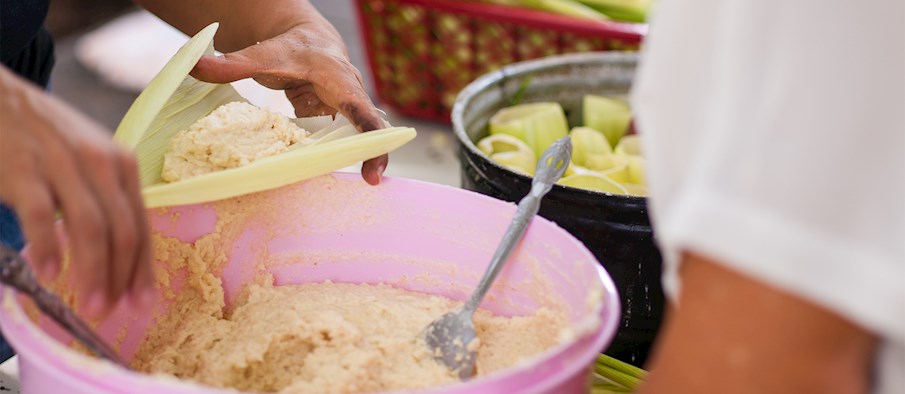Tamal wrappers are a crucial element in the art of making tamales, a beloved dish with deep cultural roots. Whether you’re a seasoned cook or just starting out, understanding the different types of tamal wrappers and where to find them can elevate your cooking experience. This guide explores the most popular options, their benefits, and where to purchase them.
Understanding the Role of Tamale Wrappers
Tamal wrappers serve multiple purposes in the cooking process. They help maintain the shape of the tamale, prevent the masa from sticking to the steamer, and impart a subtle flavor to the finished product. Traditional corn husks offer a distinct, slightly sweet corn flavor, but other materials can also be used effectively.
Key Considerations for Choosing a Wrapper
- Pliability: The wrapper should be flexible enough to wrap around the masa without tearing.
- Heat Resistance: It must withstand the high temperatures of steaming without melting or burning.
- Food Safety: Ensure the material is safe for food use and does not leach harmful substances.
Popular Tamal Wrapper Options
1. Corn Husks
Corn husks are the traditional choice for wrapping tamales. They add a subtle, earthy flavor and help keep the tamale moist during cooking. To prepare corn husks, soak them in warm water for about 30 minutes to make them pliable.
Pros:
– Adds a natural corn flavor
– Keeps the tamale moist
– Traditional and authentic
Cons:
– Require soaking and preparation
– May not be readily available in all regions
2. Banana Leaves
Banana leaves are a popular alternative, especially in tropical regions. They impart a slightly sweet and aromatic flavor, enhancing the overall taste of the tamales. To use banana leaves, briefly pass them over an open flame or steam them to make them more pliable.
Pros:
– Adds a unique flavor
– Moisture-retaining properties
– Visually appealing
Cons:
– May require additional preparation
– Not always available in local stores
3. Parchment Paper
Parchment paper is a convenient option that requires no preparation. It is widely available and easy to use, making it ideal for those looking for a quick solution. However, it does not contribute any flavor to the tamales.
Pros:
– Easy to use
– No need for soaking or heating
– Non-stick properties
Cons:
– No flavor contribution
– May stick to the tamale if not properly greased
4. Aluminum Foil
Aluminum foil can be used as a last resort when other options are unavailable. While it is effective at containing the tamales, it may impart a metallic taste if used for extended periods. To mitigate this, line the foil with parchment paper.
Pros:
– Readily available
– Effective at containing the tamale
Cons:
– May affect flavor
– Not ideal for long cooking times
5. Other Uncommon Alternatives
Some adventurous cooks have experimented with other materials such as cabbage leaves, grape leaves, and oatmeal paper. These alternatives offer unique flavors and textures, but it’s essential to ensure they are food-safe and properly prepared.
Pros:
– Unique flavor profiles
– Eco-friendly options (e.g., oatmeal paper)
Cons:
– May require additional preparation
– Limited availability
Techniques for Wrapping Tamales
Regardless of the wrapper you choose, the basic technique for wrapping tamales remains the same:
- Prepare the Wrap: Soften or cut the wrap into appropriate sizes.
- Spread the Masa: Place a portion of masa in the center of the wrap and spread it into a thin, even layer.
- Add the Filling: Spoon the desired filling onto the center of the masa.
- Fold and Secure: Fold the wrap over the filling, creating a sealed package. Tuck in the ends to prevent the filling from escaping. If necessary, use kitchen twine to secure the tamales.
Steaming Tamales to Perfection
Steaming is the most common method for cooking tamales. It ensures that the masa cooks evenly and remains moist.
Steps to Steam Tamales:
1. Prepare the Steamer: Fill a steamer with water, ensuring that the water level is below the steamer basket.
2. Arrange the Tamales: Place the wrapped tamales vertically in the steamer basket, packing them tightly to prevent them from unfolding.
3. Steam: Cover the steamer and steam the tamales for the recommended time, typically 1 to 2 hours, depending on the size of the tamales.
4. Check for Doneness: The tamales are done when the masa is firm and pulls away easily from the wrap.
Tips for Success with Alternative Wraps
- Experiment: Don’t be afraid to try different wraps to see what works best for you.
- Prepare Thoroughly: Properly prepare the wraps by softening or cleaning them as needed.
- Secure Tightly: Ensure that the tamales are securely wrapped to prevent the filling from escaping.
- Monitor Steaming Time: Adjust the steaming time as needed, depending on the wrap and the size of the tamales.
Conclusion: Embracing Tamale-Making Flexibility
While traditional corn husks are a classic choice for wrapping tamales, a variety of alternatives can be used successfully. Banana leaves, parchment paper, and even less common options like cabbage leaves offer unique flavors and textures. By understanding the role of the wrap and experimenting with different materials, you can enjoy delicious tamales regardless of husk availability. The key is to choose a wrap that is food-safe, heat-resistant, and complements the flavor of your filling. So, get creative and explore the world of tamale-making beyond the husk! Remember that the most important ingredient is love and care in the preparation. Happy tamale-making!


Frequently Asked Questions

What are some alternative wrapping options for tamales besides corn husks?
While corn husks are the traditional and most common choice, several alternatives can impart unique flavors and textures to your tamales. Banana leaves are a popular choice, particularly in tropical regions, providing a subtle sweetness and a distinct aroma. Parchment paper can be a convenient option for those seeking a readily available and easy-to-use alternative. Additionally, some cooks experiment with Swiss chard leaves or even specialized tamale paper.
How does using banana leaves affect the flavor and texture of tamales?
Using banana leaves infuses tamales with a subtle, slightly sweet flavor and a unique aroma that is reminiscent of tropical cuisine. The leaves contribute a moistness to the tamales during steaming, resulting in a tender and slightly sticky texture. The essential oils released from the banana leaves during cooking permeate the masa and filling, adding a depth of flavor that is difficult to replicate with other wrappings. Moreover, the banana leaves create a protective barrier, ensuring that the tamales retain their moisture and prevent them from drying out. This results in a more succulent and flavorful final product compared to some other wrapping alternatives.
What are the benefits of using parchment paper for wrapping tamales?
Parchment paper offers several practical benefits for wrapping tamales, primarily convenience and accessibility. It is readily available in most grocery stores and requires no special preparation other than cutting it to the appropriate size. Its non-stick properties prevent the tamales from sticking to the wrapping, making for easy removal and serving. Furthermore, parchment paper is heat-resistant and safe for steaming, ensuring that it won’t leach any unwanted chemicals into the food. It provides a neutral flavor profile, allowing the filling’s taste to shine through without interference. Parchment paper is a suitable option for those seeking a simple and efficient alternative to traditional corn husks, especially when time is of the essence.
How do I prepare banana leaves for wrapping tamales?
Preparing banana leaves involves cleaning and wilting them to make them pliable. First, thoroughly wash the leaves with warm, soapy water to remove any dirt or debris. Rinse them well and pat them dry. Next, pass the leaves over an open flame or immerse them briefly in hot water to soften them, preventing them from tearing when folded. Wilting the leaves makes them more manageable and easier to wrap around the tamale filling. The heat helps to break down the fibers in the leaves, making them more flexible. After wilting, trim the leaves into the desired size and shape for wrapping. They are then ready to be used to create delicious and aromatic tamales.
Can other types of leaves, like Swiss chard, be used for wrapping tamales?
Yes, alternative leafy greens like Swiss chard can be employed as wrappers for tamales, offering a unique twist on the traditional approach. These leaves should be large, sturdy, and preferably organic. They contribute a slightly earthy and vegetal flavor to the tamales, offering a different taste profile than corn husks or banana leaves. However, it’s important to blanch or steam the leaves briefly before use to soften them and make them more pliable for wrapping. This also helps to reduce any bitterness in the leaves. Keep in mind that the cooking time might need to be adjusted depending on the thickness and texture of the leaves. Experimentation is key to perfecting the technique with different types of leaves.
Are there any special considerations when steaming tamales wrapped in alternatives to corn husks?
When steaming tamales wrapped in alternative materials, consider the moisture content and heat conductivity of the wrapping. Banana leaves and Swiss chard retain moisture more effectively than parchment paper, which may require adding extra water to the steamer to prevent the tamales from drying out. Monitor the water level in your steamer throughout the cooking process. The cooking time might also need slight adjustments depending on the type of wrapping. Tamales wrapped in thicker materials like banana leaves might require a longer steaming time to ensure the masa is fully cooked through. Check for doneness by unwrapping one tamale and ensuring the masa is firm and pulls away cleanly from the wrapping. Remember to always use a reliable steamer and follow proper steaming techniques.
Where can I find specialized tamale paper?
Specialized tamale paper, often referred to as “hojas para tamales,” can be found at a variety of locations, both online and in physical stores. Mexican or Latin American grocery stores are excellent places to start your search, as they typically stock a wide range of authentic ingredients and cooking supplies. These stores often carry both dried corn husks and alternative wrapping options. Online retailers like Amazon and specialty food websites also offer a diverse selection of tamale paper. When purchasing online, carefully review product descriptions and customer reviews to ensure you are getting the desired size, quality, and quantity. Some online stores also offer bundles that include both the paper and other tamale-making supplies, providing a convenient one-stop-shop option.












More Stories
US Trending News: How to Claim Your Joy: A Guide to Finding Happiness and Inner Peace
US Trending News: Explore Www.hobbylobby.com: Your Ultimate Guide to the Official Site
When Is Trick Or Treating in 2024: A Complete Guide for Halloween